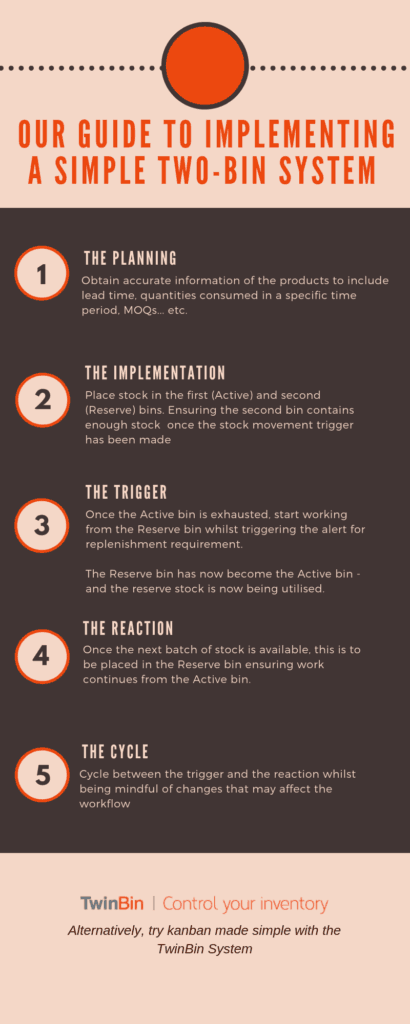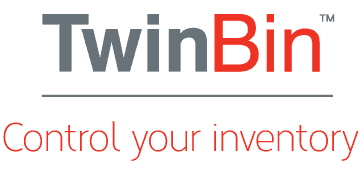The latest, most technologically advanced addition to the TwinBin range is now here – TwinBin Live.
TwinBin Live further develops the TwinBin range by adding cloud-based functionality, coupled with instantaneous stock control.
The TwinBin range has been developed using KanBan methodology. It is a system that works by storing reserve stock above active stock. Once the active stock has been depleted you simply pull the slider to release the reserve batch leaving the upper chamber ready for new stock.
TwinBin Live updates in real time, anywhere.
This means full control at all times, bringing cost savings, as inefficient stock control can cost significantly in terms of both time and money.
What are the benefits of TwinBin Live?
- Cost control and savings
- Full parts traceability
- Reduces stock held
- No missed scans
- Provides a fully secure communications network
- JIT (Just In Time) delivery
- First In First Out (FIFO) stock rotation
- Fully modular – Easy to change and adapt to changes in workflow.
- Quick and easy to install
- Fits seamlessly with existing TwinBin systems
TwinBin Live incorporates a full cloud-based data feature set, with an Android-based app for simple access and full management reporting.
The TwinBin Live components themselves incorporate a battery-based power source, with a 7+year life, meaning no power supply required to the racking.
The TwinBin Live bins also carry “intelligent” functionality, meaning they can prevent sabotage from staff and also monitor their own battery life.
INVENTORY MANAGEMENT THAT WORKS
Inventory control and inventory tracking can bring significant cost savings in the long run.
Proper inventory management means less stock lost, less time invested and more efficient processes. TwinBin Live can make this process as straight forward as possible, with full control at your fingertips, anywhere and anytime.
Adhering to Kanban principles, TwinBin Live adds Bluetooth and cloud-based functionality to an already proven stock management system, TwinBin.
The most basic and simple implementation of a Kanban system can be done through a two-bin system.
There needs to be a trigger in the Kanban system to display a visual signal once the replenishment request has been activated. This can be a simple signal such as a Kanban card or something complex as an RFID Alert, or in the case of TwinBin Live, fully automated bin scanning.
Imagine the convenience of automatic stock reordering – simple, effective and minimal management time.
SO WHY TWINBIN LIVE?
At its simplest level, TwinBin Live facilitates Kanban methodology in any production or process environment incorporating the system.
Kanban is a methodology in lean manufacturing which manages and improves workload within production.
From Japanese roots in automotive manufacturing environments, the word ‘Kanban’ can be roughly translated to mean ‘Visual Signal’ and is used as a Just-In-Time (JIT) method of inventory control.
The aim of a Kanban System is to eliminate excess inventory throughout the production cycle and align inventory levels with actual consumption, whilst highlighting any inefficiencies within the supply chain.
HOW CAN YOU IMPLEMENT KANBAN USING THE TWINBIN SYSTEM?
The most basic and simple implementation of a Kanban system can be done through a two-bin system.
Please see below our guide to implementing a simple two-bin system:
- Firstly, gathering information and planning is crucial for all items wishing to be stored in a Kanban system. Important information such as quantities used, the lead time and product MOQs need to be understood and analysed for the two-bin system to work. If this is not completed correctly then there may be too much, or too little stock available and the system will fail.
- Once enough data has been gathered and researched, it is time to implement the two-bin system. The stock needs to be placed in the two-bin system, ensuring the second bin contains enough stock for production to continue once the stock replenishment trigger has been activated – this information should be available from all the data gathered during the planning stage.
- There needs to be a trigger in the Kanban system to display a visual signal once the replenishment request has been activated. This can be a simple signal such as a Kanban card or something complex as an RFID Alert (or by using our TwinBin System which does this for you!).
- Ensure that production begins with the first bin, which we call the ‘Active Bin’. Once the stock is exhausted, production moves on to the second bin, which we call the ‘Reserve Bin’. Once the reserve bin comes into play, it then changes to become the active bin. A visual signal then needs to be triggered in order for stock movement requirement to be activated.
- Once more stock has become available, this needs to be placed into the (now empty) reserve bin and placed back into production to be utilised once the active bin is exhausted.
- Once the reserve bin has been replenished, this then resets the cycle whilst production continues.
- It is important to note that regularly returning to the planning stage is crucial to ensure to the efficient running of the Kanban system, regularly checking for changes in lead times, MOQs and changes in production that can influence the Kanban system.



